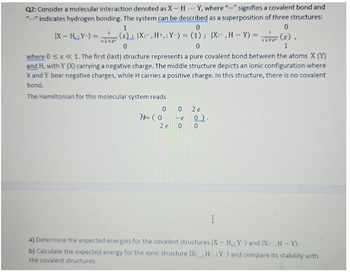
Chemistry
10th Edition
ISBN: 9781305957404
Author: Steven S. Zumdahl, Susan A. Zumdahl, Donald J. DeCoste
Publisher: Cengage Learning
expand_more
expand_more
format_list_bulleted
Question

Transcribed Image Text:Q2: Consider a molecular interaction denoted as X-HY, where "-" signifies a covalent bond and
"..." indicates hydrogen bonding. The system can be described as a superposition of three structures:
|X-HY-)=
V1+s
1
0
(s) |X:, H+,: Y-) = (1); |X:-, H-Y) =
0
0
0
(s),
1
where 0 < s << 1. The first (last) structure represents a pure covalent bond between the atoms X (Y)
and H, with Y (X) carrying a negative charge. The middle structure depicts an ionic configuration where
X and Y bear negative charges, while H carries a positive charge. In this structure, there is no covalent
bond.
The Hamiltonian for this molecular system reads
0 0
2€
2€
0
H=(0 -E
မဝါဝ
I
a) Determine the expected energies for the covalent structures IX-H, Y) and (X:-, H-Y).
b) Calculate the expected energy for the ionic structure IX: H: Y) and compare its stability with
the covalent structures.
SAVE
AI-Generated Solution
info
AI-generated content may present inaccurate or offensive content that does not represent bartleby’s views.
Unlock instant AI solutions
Tap the button
to generate a solution
to generate a solution
Click the button to generate
a solution
a solution
Knowledge Booster
Similar questions
- G.231.arrow_forward3.arrow_forward2. · Both CCla (carbon tetrachloride) and CS2 (carbon disulfide) are liquids used as solvents in special industrial applications. Using data from the appendix and recognizing that S298 K(Cl02) = 257.22 J K-'mol-,calculate AH° and AG° for combustion of these liquids at 298 K: CCL,(1) + 502(g) 298K Co2(g) + 4C102(g) 298K CS2(1) + 302(g) - CO2(g) + 2so2(g) Based on your results, would you recommend special precautions against fires for industrial plants using either solvent? Explain your recommendationsarrow_forward
- Consider the arrangement: fly F (b) 0=45° r (nm) 0.5 1.0 1.5 4.0 +0₂ (a) = 2.0 nm 0 (degree) 0 45 90 180 +Q₁ Calculate the molecular potential energy of interaction between two HCI molecules (μ = 1.08 D) at the given separations (r) and angles (0). Comment on your results. V (J/mol) 8 -Q₂ V (J/mol)arrow_forwardi need the answer quicklyarrow_forwardENTROPY AND FREE ENERGY Estimating a phase transition temperature from standard therm... DENNIS Using the thermodynamic information in the ALEKS Data tab, calculate the boiling point of bromine (Br,). Round your answer to the nearest degree. x10 X 5 nData X [+] Bond energies For example, the energy it takes to break an oxygen-hydrogen single bond, or carbon-carbon double bond. [-1 Thermodynamic properties of pure substances Standard thermodynamic quantities for selected substances at 25°C listed alphabetically by most important atom. AG (kJ/mol) So (J/mol-K) AHf (kJ/mol) substance Aluminum -485.0 Al3+ (aq) 28.3 0 Al (s) 0 50.9 -1582.3 Al203 (s) -1675.7 -1147.25 Al(OH)3 (s) Bromine -104.0 Br (aq) 152.2 0 Br2 (I) 245.5 3.1 30.9 Br2 (g) 198.7 -53.4 -36.3 HBr (g) Calcium -553.6 Ca2+ (aq) -795.4 CaCl2 (s) -634.9 CaO (s) Explanation se Privacy -985.2 Ca(OH)2 (s)arrow_forward
- For a gaseous reaction, standard conditions are 298 K and a partial pressure of 1 bar for all species. For the reaction C,H,(g) + H, (g) =2CH,(g) the standard change in Gibbs free energy is AG" = -72.6 kJ/mol. What is AG for this reaction at 298 K when the partial pressures are Pc,H, = 0.450 bar, P, = 0.400 bar, and PCH, = 0.900 bar? AG = kJ/molarrow_forwardSuppose now that argon is added to the mixture in the previous exercise to bring the composition closer to real air, with mole fractions 0.780. 0.210, and 0.0096, respectively. (a) What is the additional change in molar Gibbs energy and entropy at 298 K? (b) Is the mixing spontaneous?arrow_forward
arrow_back_ios
arrow_forward_ios
Recommended textbooks for you
 ChemistryChemistryISBN:9781305957404Author:Steven S. Zumdahl, Susan A. Zumdahl, Donald J. DeCostePublisher:Cengage Learning
ChemistryChemistryISBN:9781305957404Author:Steven S. Zumdahl, Susan A. Zumdahl, Donald J. DeCostePublisher:Cengage Learning ChemistryChemistryISBN:9781259911156Author:Raymond Chang Dr., Jason Overby ProfessorPublisher:McGraw-Hill Education
ChemistryChemistryISBN:9781259911156Author:Raymond Chang Dr., Jason Overby ProfessorPublisher:McGraw-Hill Education Principles of Instrumental AnalysisChemistryISBN:9781305577213Author:Douglas A. Skoog, F. James Holler, Stanley R. CrouchPublisher:Cengage Learning
Principles of Instrumental AnalysisChemistryISBN:9781305577213Author:Douglas A. Skoog, F. James Holler, Stanley R. CrouchPublisher:Cengage Learning Organic ChemistryChemistryISBN:9780078021558Author:Janice Gorzynski Smith Dr.Publisher:McGraw-Hill Education
Organic ChemistryChemistryISBN:9780078021558Author:Janice Gorzynski Smith Dr.Publisher:McGraw-Hill Education Chemistry: Principles and ReactionsChemistryISBN:9781305079373Author:William L. Masterton, Cecile N. HurleyPublisher:Cengage Learning
Chemistry: Principles and ReactionsChemistryISBN:9781305079373Author:William L. Masterton, Cecile N. HurleyPublisher:Cengage Learning Elementary Principles of Chemical Processes, Bind...ChemistryISBN:9781118431221Author:Richard M. Felder, Ronald W. Rousseau, Lisa G. BullardPublisher:WILEY
Elementary Principles of Chemical Processes, Bind...ChemistryISBN:9781118431221Author:Richard M. Felder, Ronald W. Rousseau, Lisa G. BullardPublisher:WILEY

Chemistry
Chemistry
ISBN:9781305957404
Author:Steven S. Zumdahl, Susan A. Zumdahl, Donald J. DeCoste
Publisher:Cengage Learning

Chemistry
Chemistry
ISBN:9781259911156
Author:Raymond Chang Dr., Jason Overby Professor
Publisher:McGraw-Hill Education

Principles of Instrumental Analysis
Chemistry
ISBN:9781305577213
Author:Douglas A. Skoog, F. James Holler, Stanley R. Crouch
Publisher:Cengage Learning

Organic Chemistry
Chemistry
ISBN:9780078021558
Author:Janice Gorzynski Smith Dr.
Publisher:McGraw-Hill Education

Chemistry: Principles and Reactions
Chemistry
ISBN:9781305079373
Author:William L. Masterton, Cecile N. Hurley
Publisher:Cengage Learning

Elementary Principles of Chemical Processes, Bind...
Chemistry
ISBN:9781118431221
Author:Richard M. Felder, Ronald W. Rousseau, Lisa G. Bullard
Publisher:WILEY